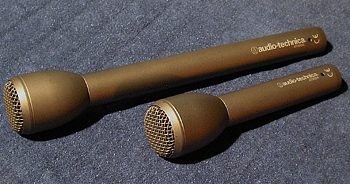Audio-Technica AT8004 8004L Mics
In the heart of every TV and video production facility there is a box, usually in the back of a cabinet, where you'll find up to half a dozen "Buchanan hammers," aka the ElectroVoice 635A.
FEATURES
The new Audio-Technica AT8004 and AT8004L models are of similar design, and have neodymium magnets that make the mics about 5 dB more sensitive than the original EV 635A. The Audio-Technica bodies have a dark grey, non-reflective, satin finish. The big difference in the two models is their length. The AT8004 measures in at 5.93 inches, with the long-handled 8004L some 3.5-inches longer at 9.43. Their diameters are about 1/16th of an inch thicker than the 635A's 1.42 inches. Although they come with a standard-threaded mic clip, the Audio-Technica should work with any mic clip you probably already have, and will also hold mic flags.
Both the AT8004 and AT8004L use the same omnidirectional dynamic element. Frequency response is listed as 80 Hz to 16 kHz, with a sensitivity rated at –51 dB (2.8 mV) re 1 V at 1 Pascal. The output impedance is 300 Ohms.
Fast Facts

Application
Studio, street or remote handheld micing jobs.
Key Features
Higher sensitivity neodymium magnet construction; long-handled version holds mic flag, dark, non-reflective finish.
Price
8004, $135; 8004L, $149
Contact
Audio-Technica US | 330-686-2600 | www.audio-technica.com IN USE
An omni is a good choice for street reporters who need to move the mic back and forth between themselves and the person they're interviewing. A cardioid is better for noise rejection, but you really have to be on your toes and make sure you get the mic positioned properly or you lose parts of sentences. Out on the street, both the AT 8004 and AT 8004L looked nice, felt good and worked well.
The AT8004 and AT8004L were identical in sound. In direct comparisons with the ElectroVoice 635A, both AT mics were about five dB more sensitive, due to the aforementioned modern and more powerful magnets. The frequency response of the 635A was a little flatter. The AT mics had a 3 to 4 dB dip at 2 kHz, followed by a 4 dB peak at 3 kHz that went beyond 6 kHz before dropping back down. At 15 kHz both microphones roll off steeply. Both AT mics show a gradual rolloff of the low end, starting at about 500 Hz and down by 5 dB at 70 Hz and 10 dB by 40 Hz. As a result, the AT8004 and AT8004L sound slightly eq'ed relative to the flatter 635A. On a busy street, convention floor or hurricane watch, the AT mics might allow a voice to cut through a bit more, depending on voice and noise types.
SUMMARY
The amount of handling noise was similar, but of slightly different spectra. The AT mic's handling noise was slightly lower in spectra. Off-axis response was very similar between the AT and 635A. If the frequency response of the 635A has always been too "plain Jane" for you, you might like the extra punch in the 2 to 3 kHz region of the 8004 and 8004L.
The amount of "popping" with the AT mics was about the same as with the 635A. A good foam ball should take care of most of these problems. I didn't try to use either the AT8004 or AT8004L as hammers, or roll my car over them, so the Buchanan hammer's reputation remains unchallenged.
Ty Ford is an independent audio/video producer based in Baltimore. He has been involved in audio/video technology for over 30 years. He may be contacted at www.tyford.com.
Get the TV Tech Newsletter
The professional video industry's #1 source for news, trends and product and tech information. Sign up below.
